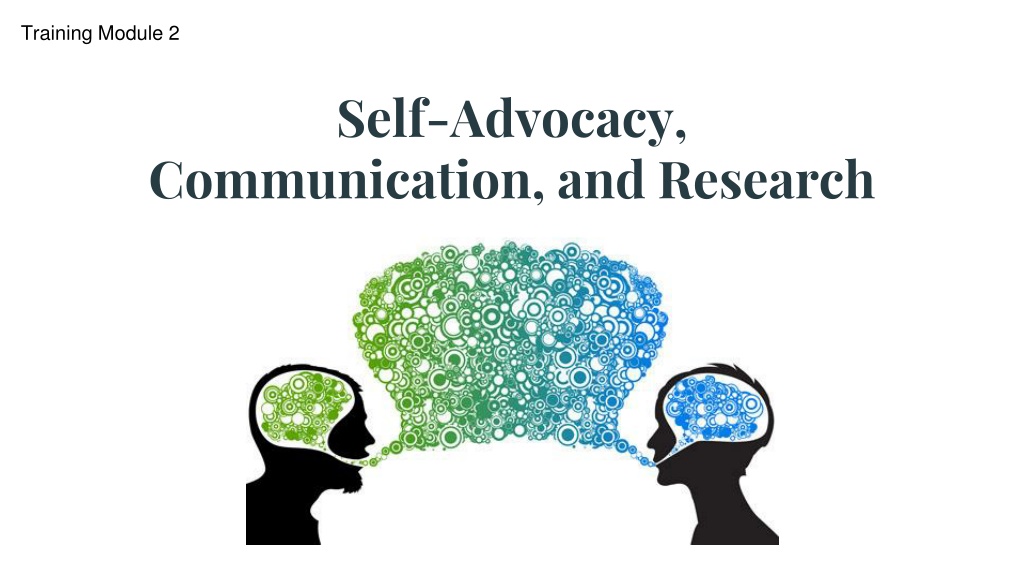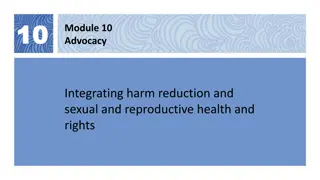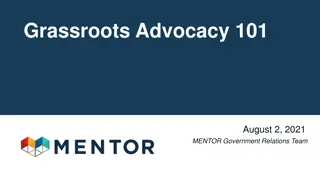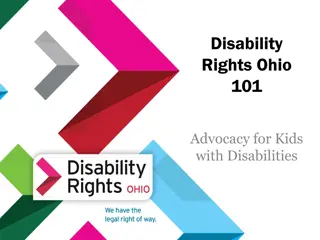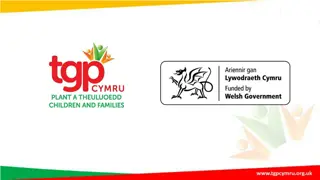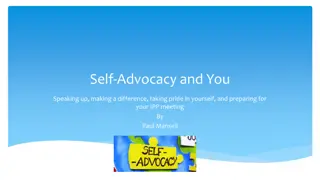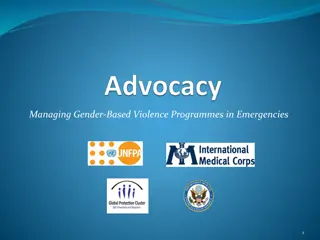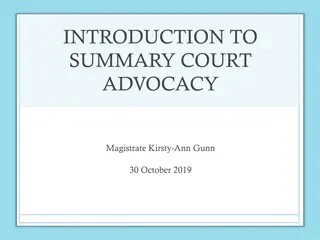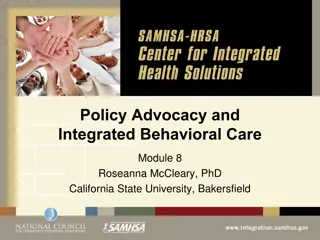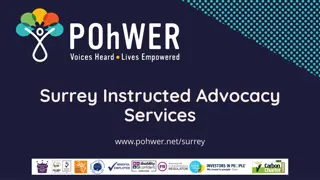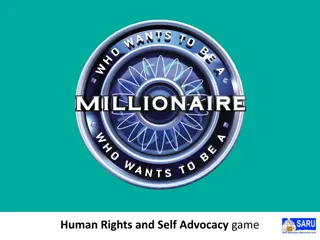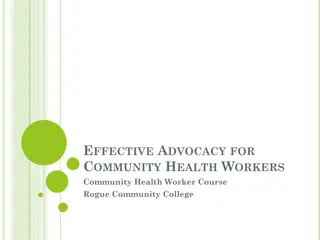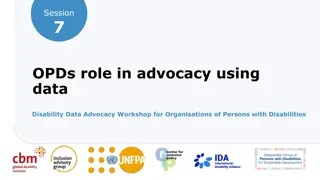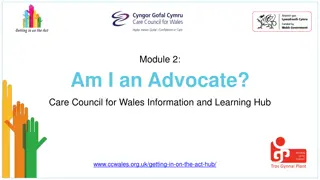Self-Advocacy, Communication, and Research
Explore the essence of self-advocacy, communication, and research in this training module. Learn to articulate your needs effectively, acquire self-advocacy skills, and identify various settings where self-advocacy is crucial. Engage in activities to assess your self-advocacy skills and reflect on how you apply them in your life.
Download Presentation

Please find below an Image/Link to download the presentation.
The content on the website is provided AS IS for your information and personal use only. It may not be sold, licensed, or shared on other websites without obtaining consent from the author.If you encounter any issues during the download, it is possible that the publisher has removed the file from their server.
You are allowed to download the files provided on this website for personal or commercial use, subject to the condition that they are used lawfully. All files are the property of their respective owners.
The content on the website is provided AS IS for your information and personal use only. It may not be sold, licensed, or shared on other websites without obtaining consent from the author.
E N D
Presentation Transcript
Training Module 2 Self-Advocacy, Communication, and Research
Part 1: What is Self-Advocacy?
What is Self-Advocacy? Learning Goal: Describe self-advocacy in your own words
Video: What is Self-Advocacy? (RTC Media, 2015)
What is Self-Advocacy? Definition: The ability to communicate your needs: Understand your needs Know what kind of support you need or might help you Communicate these needs to others
Self-Advocacy Skills Speaking up for yourself Asking questions or asking for help, as needed Asking for supports or accommodations, as needed Working with others to reach an agreement that meets your needs (negotiation) Knowing your rights and responsibilities Finding and using resources available to you
Self-Advocacy Settings At Home with Family or Friends In the Community with Workers or Service Providers At School or In the Classroom with Teachers or Classmates At Work or On the Job with Employers or Co-Workers Other? Where else do you advocate for yourself? Who else do you advocate to?
Activity: Self-Advocate Group Discussion 1. What are your needs? 2. What supports help to meet your needs?
Activity: Self-Advocacy Skills Inventory 1. Read or listen to each item on the Self-Advocacy Skills Inventory worksheet 2. Select one option for each item: Strongly Agree Agree Neutral Disagree Strongly Disagree 3. Define self-advocacy in your own words on the back of the worksheet
What is Self-Advocacy? Review: How do you use self-advocacy skills in your life?
Part 2: What is Communication?
What Are Communication Skills? Learning Goal: Describe communication skills and learning styles
What is Communication? Definition: To share information
Communication Skills Different ways of sharing information or ideas with others: Body Language Sign Language Letters, Emails, and Texts Social Media Dancing Music Symbols Other Speaking and Listening
Cs of Good Communication Clear: Be specific and concrete. Use common words, simple sentences & visuals. Concise: Be brief and to the point. Use meaningful and relevant words. Credible: Be honest and truthful. Use facts and sources for support. Confident: Be positive. Use Considerate: Be thoughtful, sincere, and appreciative. Use empathy. Collaborative: Be open and friendly. Share your ideas and listen to others.
Aggressive vs. Assertive Communication Aggressive Someone who is aggressive shows a lot of energy and has a strong impact People who are aggressive may be forceful (physically, mentally, or verbally)
Aggressive vs. Assertive Communication Assertive Someone who is assertive shows confidence and negotiation skills People who are assertive may be bold, but not harmful, in sharing ideas
Activity: What is your learning and communication style? 1. Open the VARK Questionnaire: go.osu.edu/varksurvey 2. Take the survey. 3. Record your scores. 4. What is your learning and communication style?
Activity: My VARK Communication Strategies 1. Review your VARK scores 2. Go to http://vark-learn.com/strategies/ Open the links for your top 2 scores (Visual, Aural, Read/Write, Kinesthetic) List learning and communication strategies for yourself on the worksheet i. How do you like to communicate? ii. How do you like to learn or take in information? iii. How do you like to teach or present information to others?
What is Communication? Review: What communication skills and learning style do you use most in your life?
Part 3: Self-Advocacy, Communication, and Research
Self-Advocacy, Communication, and Research Learning Goal: Describe how a research partner can self-advocate and communicate as a member of research team
Nothing about us, without us Group discussion 1. What does this phrase mean to you? 2. Why is it important to include partners with disabilities in research?
Advocacy as a Research Partner Help researchers make sure that the research study is important and helps people with disabilities Focusing too much on your own lived experience, interests, needs, or problems Ignoring the experiences, interests, needs, and problems of other people Help researchers know when ideas are not clear and make research materials and products accessible Complaining about a research study Help researchers better understand the information they find from research Being a research participant Help teach information that is learned from the research project to other people
Real-Life Stories DEEP Members How have you used self-advocacy skills as a research partner on this project? How have you communicated with other members of the research team? How can you be an advocate for the community as a partner on this project?
Video: Communication in Research McDonald, K. & Schwartz, A. (2023). Research Ethics for All
Activity: Research, Communication, and Advocacy Group Discussion 1. Review and discuss examples of clear language products made by the DEEP: https://www.rrtcnisonger.org/products/clear-language/ 2. Discuss how the research papers might be used to advocate for adults with dual diagnosis (intellectual disability and mental health condition)
Self-Advocacy, Communication, and Research Review: How will you use your self-advocacy and communication skills as a research partner on this project?
Self-Advocacy Skills Inventory
Modified Self-Advocacy Skills Inventory Strongly Agree Strongly Disagree Item Agree Neutral Disagree 1. I have the right to approve services that I get. 2. I know what to do when I have problems due to my disability. 3. I can make good decisions about what services I need. 4. I know what services I need. 5. I know how to look for services that help me. 6. I can work well with my service providers. 7. I can work with agencies to decide what services I need. 8. I can get information to help me understand my disability. 9. I know how to define self-advocacy. 10. I know about local self-advocacy or disability groups. 11. I have had the chance to join a self-advocacy or disabilities group. 12. I am a member of a self-advocacy or disabilities group. 13. I am a leader of a self-advocacy or disabilities group. 14. I know about my rights as a person with a disability.
My Communication Strategies
Name: _______________________________________________________ Learning Style Score Visual See, Observe Aural Hear, Listen Read/Write Words, Text Kinesthetic Do, Hands-on My learning style is _____________________________________________.
My Communication Strategies and Supports To take in information (VARK Strategies): ____________________________________________________________________________________ ____________________________________________________________________________________ To present information to others (VARK Strategies): ____________________________________________________________________________________ ____________________________________________________________________________________ Assistive Technology (AT) or other communication supports: ____________________________________________________________________________________ ____________________________________________________________________________________
The contents of this presentation were developed as part of a Rehabilitation Research and Training Center on Health and Function awarded to The Ohio State University Nisonger Center through a grant from the National Institute on Disability, Independent Living, and Rehabilitation Research (NIDILRR grant numbers 90RTHF0002- 01-00 and 90RTHF0006-01-00). NIDILRR is a Center within the Administration for Community Living, Department of Health and Human Services. The contents of this presentation do not necessarily represent the policy of NIDILRR, the Administration on Community Living of the Department of Health and Human Services, and you should not assume endorsement by the Federal Government.
